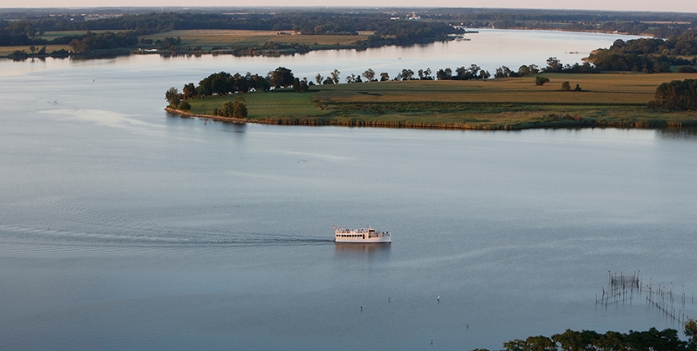
The Chester Packet Boat gliding smoothly along on the Chester River. Photo by Tyler Campbell
The Chester River earned a grade of C+ for 2017, according to ShoreRivers, the Riverkeeper organization for the mid-Shore area.
That was the key announcement at the annual State of the Chester meeting Thursday, April 26 at Washington College’s Hynson Lounge. The standing-room-only meeting was cosponsored by the college’s Center for the Environment and Society.
Isabel Hardesty, Regional Director for the Chester and Sassafras Rivers, acted as MC for the evening, which began with light hors d’ouvres featuring Orchard Point oysters from the Chester River and an open bar.
She began by introducing various ShoreRivers staff members, followed by Michael Hardesty, program administrator for the Chesapeake Bay Semester of the Center for Environment and Society – and also, as it happens, Isabel’s husband. Michael Hardesty gave a summary of the CES’s environmental programs, with a focus on the “pressing environmental issues and opportunities” currently facing the two organizations.
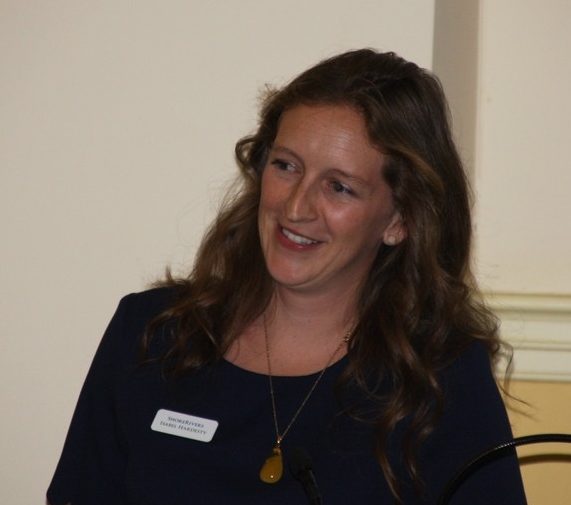
Isabel Hardesty, ShoreRivers regional director for the Chester and Sassafras Rivers
He noted the many organizations monitoring the health of the rivers and the surrounding environment, including the Sultana Education Foundation, Echo Hill Outdoor School, Sassafras Environmental Education Center, Chesapeake Bay Maritime Museum, Ducks Unlimited, Chesapeake Bay Foundation, the Nature Conservancy, and many others. “We reinforce each other in very powerful ways,” he said.
Washington College is committed to teaching the liberal arts and sciences with the goal of preparing its graduates to become “citizen leaders.” During the CES’s comparatively brief existence – it was founded in 1990 – it has become a national leader in undergraduate study of the environment, he said. It now has 26 full-time staff members and an endowment of some $10 million. And its students receive “real-world experience” aboard its research vessels and other facilities.
The college’s new environmental center, to be built on its riverside property beginning this fall, will make available an array of laboratories and classrooms to enhance the students’ learning experience. The building itself will be designed to “Living Building” standards, with solar panels and geothermal wells that produce 105 percent of the energy needed to operate the building. Any extra energy generated will be sold back to the grid, thus lowering the center’s costs and providing energy for other members of the community.
Another important ingredient of the CES’s mission is Chino Farms, where the college has operated several field stations for a number of years. Recently the farm’s owner, Dr. Harry Sears, decided he wanted “to see the students on the land for the next 100 years,” and gave the land outright to the college for its environmental programs. Among the environmental programs on the farm are a bird observation station that bands and records hundreds of birds annually, and the restored prairie that has become home to the highest concentration of the bob-white quail in Maryland. In addition, the prairie contributes to the quality of water entering the river by filtering rainwater runoff and serves as a reservoir of indigenous plant and animal species.
Hardesty concluded by recognizing the Chester Testers, who sample the water of the river and its tributaries, many of whom are alumni of the college. They “understand what it means to be a citizen in harmony with a place. George Washington would approve,” he concluded.
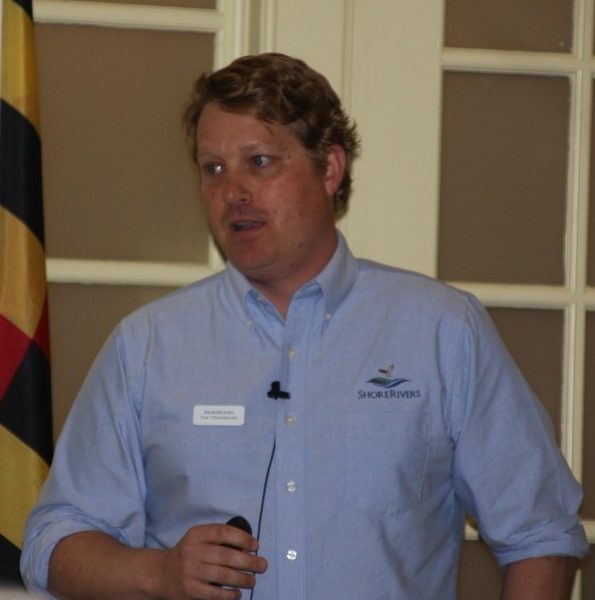
Chester River Riverkeeper Tim Trumbauer
Chester Riverkeeper Tim Trumbauer then delivered the annual report on the state of the river. He began with a slide show – “The Good, the Bad, the ?,” alternating photos of positive aspects of the river, negative impacts including algae blooms, stormwater runoff, and unhealthy development, and photos of ShoreRivers volunteer Tom Pearson – with the audience urged to cheer the good, boo the bad, and shout “Ahoy, Tom!” They responded enthusiastically!
Trumbauer said the heart of the program is the water quality monitoring, which measures several variables including temperature, acidity, clarity, and the presence of nutrients, sediment and algae. There are more than 60 Chester Testers, sampling water at sites around Kent and Queen Anne’s counties using equipment supplied by the Lamotte Company and testing facilities at Washington College. Volunteers come from Heron Point, Kent School, Gunston School and other local organizations.
The three key points arise from the testing results, Trumbauer said. One–there is pollution in the river. Two–it derives from local sources; and three–restoration works to improve water quality. He noted that the Baltimore sewer system and the Conowingo dam are not significant contributors to the state of the river, whereas agricultural practices, residential lawn care and stormwater runoff from the towns in the two counties are major sources of the current pollution. But the water in the river and its tributaries has improved from a D+ grade 10 years ago to a C+ the last several years, largely due to restoration practices. Nitrogen and phosphorus have been reduced, and water clarity is noticeably improved. In another 10 years, he said, we can hope to see the grade improved to B+.
Trumbauer said there are 77 ongoing restoration projects in the Chester River watershed, which together have resulted in a reduction of pollution entering the river by 31,000 pounds of nitrogen pollution, 10,000 pounds of phosphorus, and 1.3 million pounds of sediment.
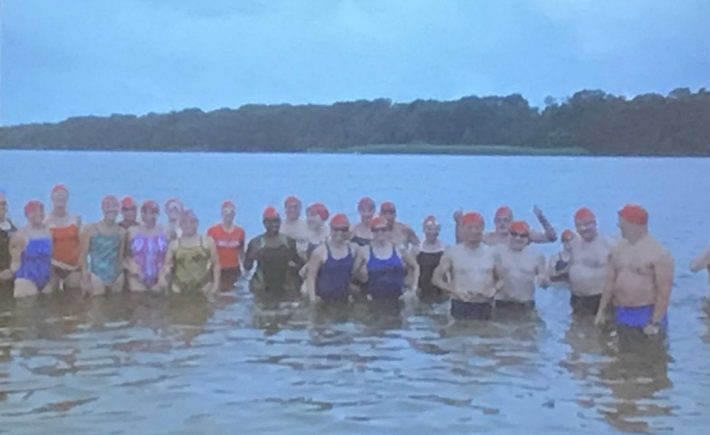
Slide from the presentation showed happy swimmers enjoying the river.
It can be safe to swim in the river, he said, as long as it is not within 48 hours of a heavy rainfall and the swimmer has no open wounds. However, swimmers should shower after leaving the river. He also recommended checking out the current state of a river at the SwimGuide website. This site covers water quality for over 7,000 freshwater and marine beaches and popular swimming areas in Canada, the USA, Mexico, New Zealand, Australia, and the Bahamas. They even have a free downloadable app for your phone!
To do their part for the health of the river, he said, farmers need to study and implement best practices for fertilizing their crops and for using pesticides. Homeowners should also reduce the amount of fertilizer they use, and introduce native plants into their lawns and gardens. “And tell your neighbors and support us,” he concluded.
Emily Harris, ShoreRivers watershed manager, followed up with hints for homeowners on making their lawns and gardens river-friendly. Reducing the use of turf grasses and fertilizers, and putting the emphasis on native plants – especially in rain gardens and buffers– can make a big difference, she said. ShoreRivers sponsors a series of yard workshops, conducted by master gardeners, that can help individual homeowners arrive at a plan that fits their own property.
A lively question-and-answer period concluded the evening. It was clear from both the number and the detail of the questions asked that the audience members were well-informed and very concerned about the state of our waterways.
This meeting was one of five “State of the Rivers” series across the area. The final presentation which will cover the Wye and Chester Rivers and the Eastern Bay will be held at 5:30 pm on Wednesday, May 16 at the Chesapeake Bay Environmental Center, 600 Discover Lane, in Graysonville. Speakers there will include the Miles-Wye Riverkeeper Elle Bassett and the Chester Riverkeeper Tim Trumbauer.
ShoreRivers has a large cohort of volunteers–citizen scientists, river testers, and others who help to gather data and work on the various projects. Anyone interested in becoming a member, donating or volunteering for a project should visit the ShoreRivers website or contact Kristan Droter at [email protected] or 443.385.0511.
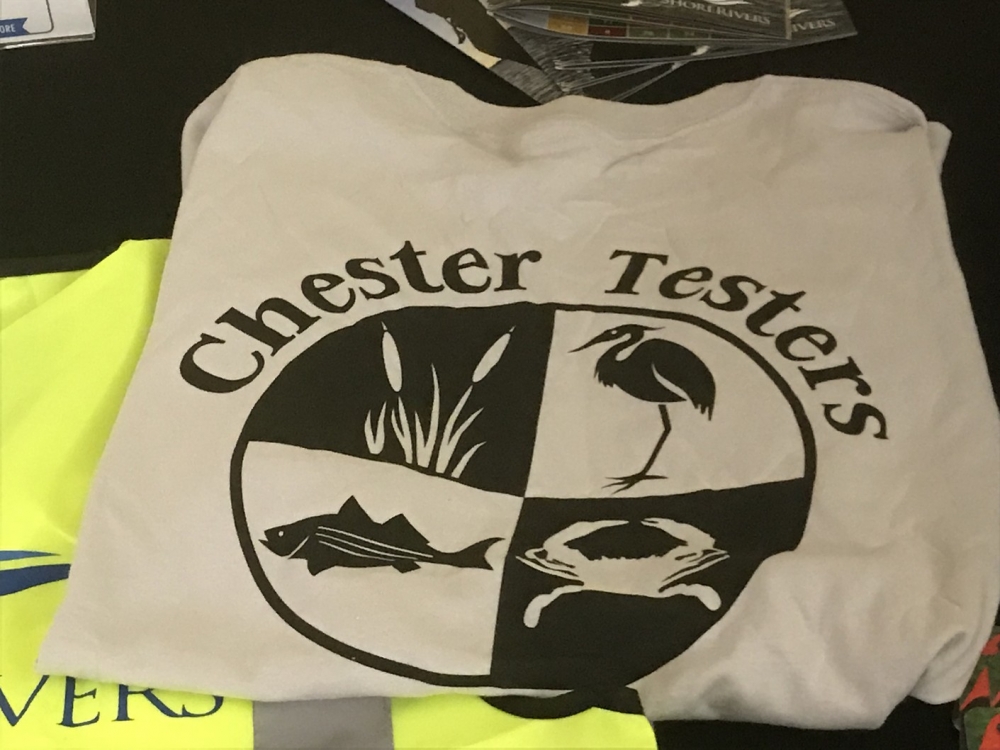
Volunteers regularly take samples of the river water and vegetation. The compiled data helps in monitoring water quality and tracking any changes in the river or the surrounding flora and fauna.
###



Write a Letter to the Editor on this Article
We encourage readers to offer their point of view on this article by submitting the following form. Editing is sometimes necessary and is done at the discretion of the editorial staff.